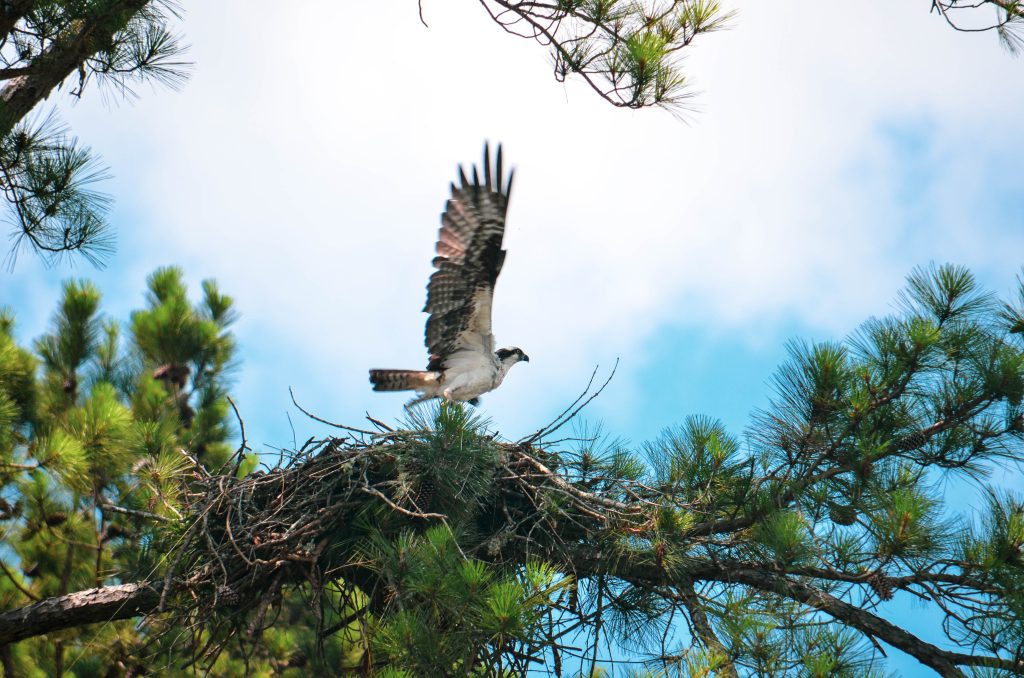Troup County is praised among birdwatchers for its vibrant ecosystem that provides 26,000 acres of refuge for wildlife. Within the county, West Point Lake hosts 525 miles of shoreline surrounded by pine and hardwood forestry, lush and flowing fields—a hotspot for birders across the country. In January of 2010, Troup County achieved national attention when the extremely rare Ivory Gull was spotted in the area. Since then (and since COVID-19 shutdowns in 2020), the county continues to gain popularity among experienced and first-time birders, scientists, ecologists and the like.
What Is Birdwatching?
Birdwatching is an outdoor recreational activity many people enjoy as a hobby, with some birders taking it a step further as a citizen’s way to give back to science. It’s a relaxing way to get outdoors, connect with nature and appreciate native habitats.
One key to birdwatching is understanding migration, seasonal migrations and what to expect for the time of year you’re observing.
Birds rely heavily on two resources to survive—food and nesting spots. Temperature plays a crucial role in these resources and affects the timing of a species’ migration.
Migratory birds experience two migrations every year. The fall migration occurs as the resources in the habitat drop and birds flock to their nonbreeding grounds (wintering grounds) in warmer areas. Spring migration is the return of birds to their breeding grounds. As temperatures in an area rises in spring, the resources amplify in the ecosystem as flowers begin to blossom and insects return. This is often when we see a habitat’s highest volume of bird species for the year.
That being said, there are hundreds of species of nonmigratory birds. In Troup County, we call these our feathered locals!

The Seasons & Birdwatching – Species Watchlist
It’s been noted the peak months for birdwatching in Troup County are October through April. The county sees its most variety of species during these months, so birders flock to the area to take in the abundance of migratory and year-round birds.
Below are some of our favorite feathered friends and when to observe them!
Year-Round Birds: Feathered Locals
Thanks to West Point Lake and the county’s lush forests, year-round you’ll find an abundance of woodpeckers, bluebirds, geese and beyond.
Found flocking together in open and wetland habitats, the Canada Goose is a large, brown goose with a black neck and white chinstrap—similar to Cackling Geese only larger. Often these two species can be spotted around Troup County in intermixed flocks! The Double-crested Cormorant, with its dark plumage and bright orange skin, relishes every season of life on West Point Lake. Swimming like a duck in between its deep dives for fish, the Double-crested Cormorant is a favorite among local wildlife photographers.
Mallards live it up on the lake year-round, as Osprey are spotted flying overhead, scanning the water for fish. Large raptors with intimidating talons, Osprey sport a mostly white head and undercarriage with a dark brown back. Tacking onto the list of immense winged creatures, the Bald Eagle is always a sight to behold. Despite its impressive appearance, Bald Eagles lack strong vocalization, expressing themselves through a series of high-pitched whistles!

Winter
Found in bays, estuaries and lakes in winter, the Bufflehead is an unexpected treat! A tiny diving duck, biology determines the Bufflehead’s appearance. Breeding males and mature males and females differ—breeding males are mostly black and white with a white spot on the back of the head, while the latter are gray-brown often with a white patch on the cheek. Striking in another right, the Lesser Scaup is another diving duck, mostly black or brown with a bright, piercing yellow eye. Overheard the gulls soar—Herring Gulls, Ring-billed Gulls and Bonaparte’s Gulls are observed most often. Popular in winter, you may lock eyes with one or all of these birds around Troup County!
Spring Migration & Summer
Spring brings another wave of life to West Point Lake. If you keep your eyes peeled, this time of year warblers head north, offering us fleeting glimpses of their yellow coats as they pass over Troup County. Sightings of Swallows begin in Spring and can be seen into summer! Purple Martins are larger swallows that typically depart its breeding grounds after summer. Adult males have overall dark plumage with a purple-blue iridescence, sometimes only visible at close range. Females appear grayer in appearance, with the same shade of iridescence, only more slight, along the crown and back. Immature Purple Martins lack this purple-blue iridescent hue, which can make identifying the species tricky at times! But, if you can’t rely on your eye, try your ear! Purple Martins vocalize with a distinctive, liquid gurgling call.
Fall
Spotted around West Point Lake in late fall, the American Coot is a chubby, chicken-like bird that thinks it’s a duck. Found coasting on the water, chowing down on lake vegetation, the American Coot’s dark plumage, white bill and red eyes make an interesting combination. Another feathered-friend fall brings to town is the Gray Catbird! Given its name for its most common call, which sounds like a cat’s raspy mew, the Gray Catbird is a gray-colored songbird with an identifiable black cap! Known to sometimes mimic the sounds of other species and spin out a jumbled song, the Gray Catbird tends to keep to shrubbery and forested areas.
Hot Spots Around WPL
- West Point Lake Dam
- Blanton Creek Wildlife Management Area
- Pyne Road Park
- For those seeking a view from the water Highland Marina provides full-service rentals!
Tips & Reminders
- Pack your binoculars!
- Leave no trace.
- Keep quiet to avoid sudden movements—don’t scare off the birds!
- Please do not feed the wildlife!
- Helpful Resources:
- EBird – Through The Cornell Lab of Ornithology
- The National Audubon Society
- Merlin Bird ID
Birdwatching requires patience and planning, but it’s a grounding hobby that reconnects us with nature. As one of Georgia’s top birdwatching destinations, Troup County boasts endless birding opportunities!